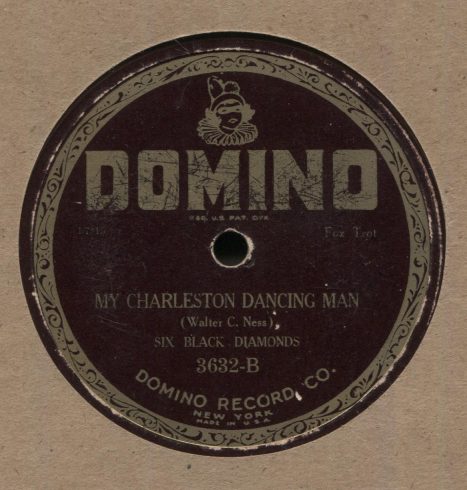
“My Charleston Dancing Man”
Six Black Diamonds
(Domino 3632 B mx 6315-3) November 28, 1925
“Spanish Shawl”
Missouri Jazz Band
(Domino 3632 A mx 6312-5) December 14, 1925
Here are two selections from one of the records in the late Edward Mitchell’s collection. Both are excellent examples of sort of “hot” dance recordings that were popular during the mid-1920s Charleston craze. Eddie had a lot of hot dance records from this period in his collection which will be added to the Radio Dismuke playlist in the weeks and months ahead.
The artist credits behind both of these selections illustrate the convoluted and sometimes confusing world of 1920s and 1930s recording pseudonyms.
The selections here were transferred from a Domino record. Domino was a budget-priced record label produced by the Plaza Music Company which also made the budget-priced Regal, Banner and Oriole labels.
In addition to Domino, both of these selections were also issued on other Plaza labels, sometimes with completely different artist credits.
On Domino, “My Charleston Dancing Man” is credited to the Six Black Diamonds. There was no such actual band – it was merely a recording pseudonym, in this case, for the Nathan Glantz Orchestra. But Nathan Glantz wasn’t the only bandleader to record under that pseudonym. Other records credited to the Six Black Diamonds were recorded by the Joseph Samuels, Adrian Schubert and Sam Lanin bands, among others.
The recording was also credited to the Six Black Diamonds on the Banner label. But on the Regal label, the artist’s credit was listed as The Missouri Jazz Band. On the Oriole label, it was credited to the Dixie Jazz Band.
The recording on the flip side, “Spanish Shawl,” was credited on this Domino disc as well as on the Banner label to the Missouri Jazz Band which was, in this instance, Ben Selvin and His Orchestra. But on the Regal label, it was credited to the Imperial Dance Orchestra. On Canadian pressings, it was credited to Fletcher Henderson and His Orchestra, an actual band headed up by one of the major talents in American jazz history but which did not participate in the recording session.
There were several reasons why such recording pseudonyms were used. In the case of companies such as Plaza, sometimes a label was pressed specifically for sale through a particular retail chain and they wanted to differentiate one chain’s offerings from another. Sometimes a major artist, such as Duke Ellington, might have been under an exclusive contract with one record label but was allowed to record for other labels so long he didn’t do so under his real name. In most cases, the labels had their own in-house studio orchestras whose recordings were often issued under a pseudonym.
What this meant, however, was that many a 78 rpm record buyer, both then and now, excited over discovering a different version of a favorite song, purchased a record only to discover upon playing it at home that it is an exact copy of a record they already had. That has happened to me more than once.
– Dismuke
